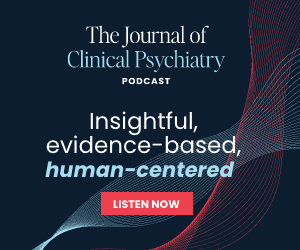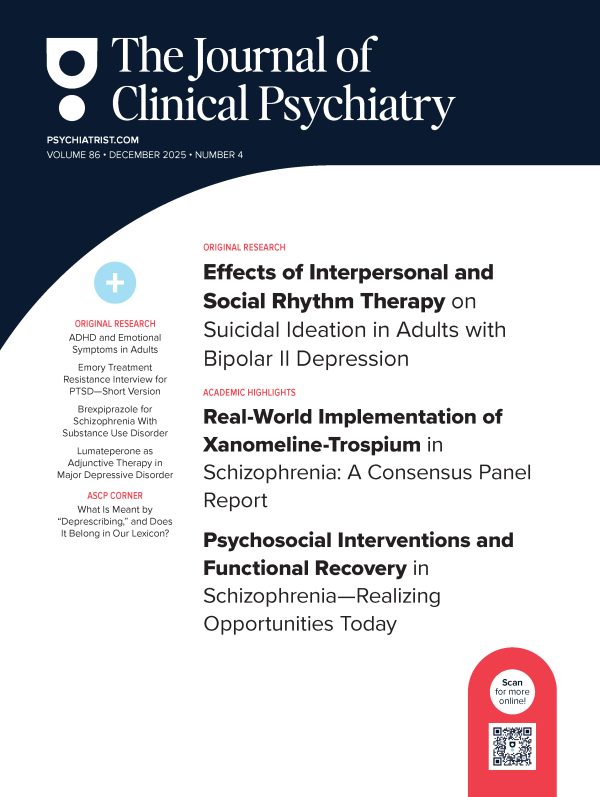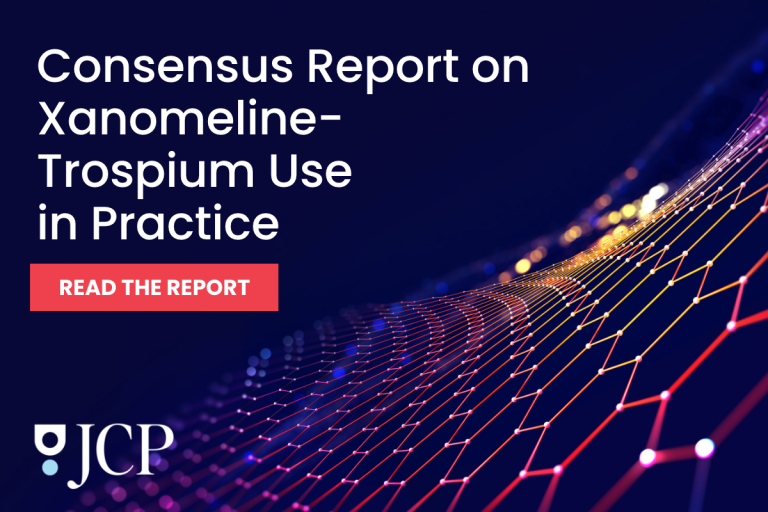See letter by Ferré and Michaelides and article by Fava et al
To the Editor: We appreciate the opportunity to respond to the letter by Drs Ferré and Michaelides1 regarding the mechanistic characterization of esmethadone (S-methadone).
In their letter, Ferré and Michaelides raise two main concerns in relation to the article by Fava and colleagues2 titled “Long-Term Safety and Efficacy of Esmethadone in Patients with Major Depressive Disorder: Findings From a 12-Month Open-Label Study.” Their first concern relates to the classification by Fava and colleagues of esmethadone as a novel uncompetitive N-methyl-D aspartate receptor (NMDAR) antagonist; their second concern is related to a statement regarding esmethadone’s lack of meaningful abuse liability.
Ferré and Michaelides exclude uncompetitive NMDAR antagonism as a plausible mechanism for the rapid antidepressant effects of esmethadone, based on the autoradiography and hot plate experiments presented by Levinstein and colleagues.3 We have already presented the reasons for maintaining the classification of esmethadone among the emerging class of uncompetitive NMDAR antagonists with therapeutic potential as rapid antidepressants in a letter to the editor of Molecular Psychiatry,4 which commented the Levinstein article.3 We have also seen Levinstein’s reply.5
As outlined by Dr. Pappagallo and colleagues,4 uncompetitive NMDAR antagonists may be uniquely effective as clinically tolerated rapid antidepressants because they only bind and block open channels (activity-dependent) at graded resting membrane potential in circuits relevant for major depressive disorder (MDD).6–12 Importantly, esmethadone is a positively charged molecule at physiological pH13 and a low-affinity, high trapping uncompetitive NMDAR antagonist, which is expected to preferentially block pathologically hyperactive GluN2D subunit containing NMDARs, the NMDAR subtype most sensitive to ambient glutamate and with the highest open probability during graded resting membrane potential.8 Additionally, in order to be blocked by esmethadone, NMDARs must be in the open configuration (bound by glutamate and glycine) and free of Mg2+ at resting membrane potential. Under physiological conditions, most NMDAR are blocked by Mg2+ at resting membrane potential.14 Finally, these pathologically hyperactive GluN2D-containing NMDARs susceptible to esmethadone block are expected to be only expressed by relatively few neurons within the brain circuits relevant for MDD.9,10 This very selective NMDAR engagement by low affinity uncompetitive NMDAR antagonists allows therapeutic effects without dissociative effects. The autoradiography experiment by Levinstein measures in vivo global receptor occupancy at NMDARs (via [3H]MK-801) in rat brain tissue. This experiment demonstrated that esmethadone does not measurably displace MK-801, indicating no detectable global NMDAR occupancy. However, this experiment lacks sensitivity for detecting esmethadone engagement at subtype-selective receptors (GluN2D-containing NMDARs), which are pathologically hyperactive at resting membrane potential and are localized within MDD relevant circuity. The NMDAR interactions by esmethadone postulated for its antidepressant and neuroplasticity effects are expected to occur below the detection threshold of the autoradiography experiment performed by Levinstein. Uncompetitive NMDAR antagonists showing MK-801 displacement in the experiment by Levinstein would likely cause dissociative effects in humans because of global interference with physiological NMDAR activity during action potential in neurons relevant for cognitive processing. Notably, esmethadone doses up to 6–8 times higher than the daily dose used in MDD trials did not show signals of dissociative effects in healthy volunteers or in recreational users.15,16
Selective block of hyperactive NMDARs at resting membrane potential was shown to reverse depressive-like behavior and to restore impaired neural plasticity over a decade ago.6 Those studies paved the way for the “homeostatic synaptic plasticity” hypothesis, one of the leading hypotheses for the mechanism of action of uncompetitive NMDAR antagonists as rapid antidepressants.7,9–12,17 In summary, Levinstein’s negative NMDAR occupancy result by esmethadone is consistent with the proposed mechanism of action of esmethadone as a nondissociative rapid antidepressant and is not adequate to convincingly argue against subtype specific and brain region-specific NMDAR engagement, which is activity-dependent at graded resting potential in neurons localized within dysfunctional depression-related brain circuits.
Ferré and Michaelides go on to interpret Levinstein’s hot plate results showing analgesia with high-dose esmethadone as a demonstration of opioid agonist effects and extend this interpretation to propose that esmethadone’s antidepressant effects are mediated via opioid agonism. It should be noted that antidepressant like effects were seen at 10 mg/kg esmethadone18; in contrast, at this dose, hot plate analgesic effects were minimal or absent.3,19
The dose by Levinstein associated with consistent analgesia was 30 mg/kg. When such high doses are used, different receptor systems are likely to be recruited, including the glutamatergic system. Klein and colleagues demonstrated that ketamine’s antidepressant-like effects are blocked by naltrexone but are not due to MOR agonism; they showed that endogenous opioid tone is permissive and necessary for ketamine’s antidepressant-like effects.20 Thus, esmethadone’s antidepressant effects may also require both NMDA and opiate receptor signaling10 but are not due to direct opioid agonism, similar to what has been concluded in experiments with ketamine.20
As an antidepressant candidate, 25 mg esmethadone was found to produce rapid and sustained antidepressant effects. Consistent effects, without additional benefit, were seen with 50 mg. Sustained antidepressant effects were noted after drug discontinuation, with no evidence of withdrawal. If the clinical antidepressant effects reported by Fava and colleagues2,21,22 were opioid related, we would expect heightened effects with doubling the dose. More importantly, opioid agonist effects would be expected to quickly disappear upon discontinuation and not be sustained, as was noted with esmethadone’s antidepressant effects. Using body surface area (BSA) scaling, the human equivalent dose for 30 mg/kg in rats, which was consistently analgesic in Levinstein’s hot plate experiments, corresponds to approximately 5 mg/kg, or approximately 300 mg/day for a 60 kg human adult, well above the maximum human-tolerated dose.15,23 Thus, the potential antidepressant-effective dose in humans (25 mg/day) is less than 1/ 10 of the equivalent rat dose required to induce analgesia. The lower antidepressant-like rat dose (10 mg/kg)18 and the lower potentially effective dose in humans2,20,21 further support nonopioid antidepressant mechanisms.
Opioid agonist drugs are known to cause euphoria and improve mood and have been used in the past as antidepressants, before it became clear that their efficacy as antidepressants was offset by tolerance, withdrawal, and risk of addiction.24
The second concern raised by Ferré and Michaelides is related to a sentence in the Fava article discussing the lack of abuse potential of esmethadone: “Within the racemic opioid compound, esmethadone may function as an opioid antagonist to reduce the opioid agonist effects of levomethadone.”2 In their letter,1 Ferré and Michaelides summarize their own experimental findings by stating that “S-methadone binds but specifically loses its efficacy for the MOR that forms heteromers with Gal1R, acting as a competitive antagonist.” These 2 statements are, in fact, complementary, both referring to the same phenomenon of functional antagonism, both supporting the lack of meaningful abuse potential seen in clinical trials, and do not represent a contradiction.
The effects of esmethadone in humans have been characterized in healthy volunteers, recreational substance users, and patients with MDD.2,15,16,20,21 Across all clinical trials, there is no meaningful evidence for typical opioid effects, including no euphoria, respiratory depression, sedation, withdrawal, constipation, or signal for abuse potential.
In another recent article, Levinstein and colleagues25 argue that the mechanism of action for the rapid antidepressant component of ketamine’s effects is also related to opioid agonism. Ketamine, esketamine, dextromethorphan, and memantine, molecules classified as uncompetitive NMDAR antagonists, are in clinical use and FDA-approved for various indications, including anesthesia, treatment-resistant depression, MDD, pseudobulbar affect, cough suppression, and moderate-to-severe Alzheimer disease. Esketamine and dextromethorphan/bupropion are approved for MDD indications. Esmethadone is under development as adjunctive treatment for MDD. As stated before, the comparative in vitro activity of these molecules at NMDARs was characterized in vitro by Bettini and colleagues.8 It is important to emphasize that when these molecules are administered to patients, the classic opioid effects of euphoria, addiction, tolerance, withdrawal, respiratory depression, or constipation are not seen. While ketamine and dextromethorphan exhibit abuse liability, they do not cause respiratory depression or show naloxone reversibility, hallmarks of opioid toxicity. Focusing on esmethadone, there are no documented cases of overdose or abuse involving esmethadone, and the maximum tolerated dose in clinical studies is related to vomiting, rather than sedation and respiratory depression.15 Furthermore, esmethadone and memantine, both devoid of clinically meaningful opioid-like effects, have not been found to induce typical dissociative NMDAR effects, and, as expected, both lack meaningful abuse potential. We think that this may be due to lower affinity (esmethadone) and lower trapping (memantine) at NMDARs, respectively, compared to ketamine.8,26 The clinical effects of these two uncompetitive NMDAR antagonists are clearly different from those of opioid agonists, including racemic methadone (R,S-methadone) and racemethorphan (R,S-methorphan), both potent racemic opioid agonists that include in their composition esmethadone and dextromethorphan, together with levomethadone and levomethorphan, respectively, confirming stereoselective opioid agonist effects for the levoisomers and relative inactivity for opioid-like effects for the dextroisomers of both racemates. However, some of these molecules, currently characterized as uncompetitive NMDARs, also bind and likely activate other receptors, including opioid receptors, but the contribution of these pathways to their clinical effects is unclear. In summary, as supported by converging in vitro, in vivo, and clinical evidence, esmethadone and ketamine should continue to be classified as uncompetitive NMDAR antagonists, and not reclassified as opioid agonist antidepressant drugs as suggested by Ferré and Michaelides and Levinstein and colleagues.3,5,25 The discovery and characterization of the antagonist activity of esmethadone at the MOR Gal1R heteromer by Levinstein and colleagues is an example of the importance of moving beyond affinity when unraveling the mechanism of action of molecules.
For the reasons expressed above, the “homeostatic synaptic plasticity hypothesis,”7,12,27 first introduced for ketamine, and later reproposed for esmethadone,9,10 is not contradicted by Levinstein’s experiments. The clinical pharmacology of esmethadone, showing no meaningful typical opioid effect across studies spanning decades and hundreds of subjects,2,15,18,21,22,28–30 is not reversed by Levinstein’s autoradiography and hot plate results, for the reasons detailed above. Instead, Levinstein’s experimental results complement prior experimental results for esmethadone, indicating lack of typical opioid effects at clinically meaningful doses.19,31–35 Additionally, Levinstein’s discovery that esmethadone loses efficacy at MORs forming heteromers with Gal1R may provide a mechanistic explanation for the signals for improvements in opioid use disorder outcomes observed after the transition from racemic methadone to R-methadone.36
The most compelling reason for not classifying ketamine and esmethadone as opioid agonist drugs is that their clinical pharmacology profiles differ fundamentally from those of classical opioid agonist.
We agree that further studies are needed to definitively elucidate the mechanisms underlying the rapid antidepressant effects of uncompetitive NMDAR antagonists. In the meantime, the opioid agonist hypothesis proposed by Levinstein and colleagues for esmethadone and ketamine3,5,25 remains a third line hypothesis, as also reflected in recent reviews prioritizing glutamatergic modulation and neuroplasticity rather than opioid receptor agonism.10,17 Emerging clinical data on nondissociative uncompetitive NMDAR antagonists devoid of meaningful opioid agonist effects, including esmethadone, may help refine our understanding of these mechanisms and offer insights in MDD pathophysiology. Although we do not support their opioid agonist hypothesis as the primary explanation for the antidepressant effects of ketamine or esmethadone, we wish to commend Levinstein and colleagues25 for their valuable contribution to advancing this important and rapidly evolving field of psychopharmacology.
Article Information
Published Online: September 8, 2025. https://doi.org/10.4088/JCP.25lr15973a
© 2025 Physicians Postgraduate Press, Inc.
J Clin Psychiatry 2025;86(4):25lr15973a
To Cite: De Martin S, Comai S, Mattarei A, et al. Reasons for maintaining the classification of esmethadone as an investigational uncompetitive NMDAR antagonist rapid antidepressant: reply to Ferré and Michaelides. J Clin Psychiatry 2025;86(4):25lr15973a.
Author Affiliations: Department of Pharmaceutical and Pharmacological Sciences, University of Padua, Padua, Italy (De Martin, Comai, Mattarei); Department of Biomedical Sciences, University of Padua, Padua, Italy (Comai); Department of Psychiatry, McGill University, Montreal, Quebec, Canada (Comai); Baylor College of Medicine, Houston, Texas (Kosten); Friends Research Institute, Baltimore, Maryland (Vocci); Consultant in Pharmaceutical Medicine, Kansas City, Missouri (Gorodetsky); MGGM Therapeutics, Kerhonkson, New York (Pappagallo, Manfredi).
Corresponding Author: Paolo L. Manfredi, MD, MGGM Therapeutics, MGGM LLC, 85 Baker Rd, Kerhonkson NY 12446 ([email protected]).
Drs De Martin, Comai, and Mattarei contributed equally.
Relevant Financial Relationships: Drs De Martin, Mattarei, and Comai are employed by or have received compensation from companies or institutions that received funding from Relmada Therapeutics, Inc. They have received grant support from MGGM LLC and consultant fees from Neuroarbor LLC, companies formerly affiliated with Relmada Therapeutics. Dr De Martin received fees from Aesculapius Farmaceutici for sponsored lectures. Drs Gorodetzky, Vocci, Sapienza, Kosten, Manfredi, Pappagallo, and Inturrisi have received consultant fees from Relmada Therapeutics, Inc. Dr Vocci is also a consultant for Takeda Pharmaceuticals and on the Scientific Advisory Board of Exavir Therapeutics, Inc. Drs Inturrisi, Manfredi, De Martin, Mattarei, and Comai are inventors on patents related to esmethadone. Drs Inturrisi and Manfredi are co-owners of technology related to esmethadone. The authors of this letter wish to further disclose that the determination of the antidepressant mechanism of action of esmethadone may have a direct impact on the schedule (ie, schedule II to V) classification of esmethadone, and ultimately on its availability to patients and commercial prospects.
See original research article [J Clin Psychiatry 2025;86(1):24m15438] for a complete list of disclosures.
Funding/Support: The study discussed in this letter was funded by Relmada Therapeutics, Inc, Coral Gables, Florida [J Clin Psychiatry 2025;86(1):24m15438].
Disclaimer: The views expressed in the letter are the authors’ own and do not represent those of the former developer of the experimental drug REL-1017, Relmada Therapeutics LLC, Coral Gables, FL.
Acknowledgments: The authors acknowledge expert input from Charles E. Inturrisi, PhD, and Frank L. Sapienza, MS.
References (36)

- Ferré S, Michaelides M. Misleading labeling of S-methadone as a novel N-methyl-d-aspartate receptor antagonist. J Clin Psychiatry. 2025;86(4):25lr15973.
- Fava M, Pani L, De Martin S, et al. Long-term safety and efficacy of esmethadone in patients with major depressive disorder: findings from a 12-month open-label study. J Clin Psychiatry. 2025;86(1):24m15438. PubMed CrossRef
- Levinstein MR, De Oliveira PA, Casajuana-Martin N, et al. Unique pharmacodynamic properties and low abuse liability of the µ-opioid receptor ligand (S)- methadone. Mol Psychiatry. 2024;29(3):624–632. PubMed CrossRef
- Pappagallo M, Kosten TR, Gorodetzky CW, et al. Letter to the editor regarding “Unique pharmacodynamic properties and low abuse liability of the µ-opioid receptor ligand (S)-methadone.” Mol Psychiatry. 2024;29(12):3935–3937. PubMed CrossRef
- Levinstein MR, De Oliveira PA, Casajuana-Martin N, et al. Reply to “Letter to the editor regarding “Unique pharmacodynamic properties and low abuse liability of the μ-opioid receptor ligand (S)-methadone.” Mol Psychiatry. 2025;30(4):1708–1709. PubMed CrossRef
- Autry AE, Adachi M, Nosyreva E, et al. NMDA receptor blockade at rest triggers rapid behavioural antidepressant responses. Nature. 2011;475:91–95. PubMed CrossRef
- Suzuki K, Monteggia LM. The role of eEF2 kinase in the rapid antidepressant actions of ketamine. Adv Pharmacol. 2020;89:79–99. PubMed CrossRef
- Bettini E, Stahl SM, De Martin S, et al. Pharmacological comparative characterization of REL 1017 (esmethadone-HCl) and other NMDAR channel blockers in human heterodimeric N-methyl Daspartate receptors. Pharmaceuticals. 2022;15:997. PubMed CrossRef
- Stahl SM, De Martin S, Mattarei A, et al. Esmethadone (REL-1017) and other uncompetitive NMDAR channel blockers may improve mood disorders via modulation of synaptic kinase-mediated signaling. Int J Mol Sci. 2022;23(20):12196. PubMed CrossRef
- Comai S, De Martin S, Mattarei A, et al. N-methyl-D aspartate receptors and depression: linking psychopharmacology, pathology and physiology in a unifying hypothesis for the epigenetic code of neural plasticity. Pharmaceuticals. 2024;17(12):1618. PubMed CrossRef
- Chen M, Ma S, Liu H, et al. Brain region-specific action of ketamine as a rapid antidepressant. Science. 2024;385(6709):eado7010. PubMed CrossRef
- Kim JW, Suzuki K, Kavalali ET, et al. Ketamine: mechanisms and relevance to treatment of depression. Annu Rev Med. 2024;75:129–143. PubMed CrossRef
- Bürgi HB, Dunitz JD, Shefter E. Pharmacological implications of the conformation of the methadone base. Nat New Biol. 1973;244:186–187.
- Hansen KB, Yi F, Perszyk RE, et al. NMDA receptors in the central nervous system. Methods Mol Biol. 2017;1677:1–80. PubMed CrossRef
- Bernstein G, Davis K, Mills C, et al. Characterization of the safety and pharmacokinetic profile of D-Methadone, a novel N-methyl-D-aspartate receptor antagonist in healthy, opioidnaïvee subjects: results of two phase 1 studies. J Clin Psychopharmacol. 2019;39(3):226–237. PubMed CrossRef
- Shram MJ, Henningfield JE, Apseloff G, et al. The novel uncompetitive NMDA receptor antagonist esmethadone (REL-1017) has no meaningful abuse potential in recreational drug users. Transl Psychiatry. 2023;13(1):192. PubMed CrossRef
- Krystal JH, Kavalali ET, Monteggia LM. Ketamine and rapid antidepressant action: new treatments and novel synaptic signaling mechanisms. Neuropsychopharmacology. 2024;49(1):41–50. PubMed CrossRef
- Hanania T, Manfredi P, Inturrisi C, et al. The N-methyl D-aspartate receptor antagonist d-methadone acutely improves depressive-like behavior in the forced swim test performance of rats. Exp Clin Psychopharmacol. 2020;28(2):196–201. PubMed CrossRef
- Lemberg K, Kontinen V, Viljakka K, et al. Morphine, oxycodone, methadone and its enantiomers in different models of nociception in the rat. Anesth Analg. 2006;102:1768–1774. PubMed CrossRef
- Klein ME, Chandra J, Sheriff S, et al. Opioid system is necessary but not sufficient for antidepressive actions of ketamine in rodents. Proc Natl Acad Sci U S A. 2020;117(5):2656–2662. PubMed CrossRef
- Fava M, Stahl S, Pani L, et al. REL-1017 (esmethadone) as adjunctive treatment in patients with major depressive disorder: a phase 2a randomized double-blind trial. Am J Psychiatry. 2022;179(2):122–131. PubMed CrossRef
- Fava M, Stahl SM, Pani L, et al. Efficacy and safety of esmethadone (REL-1017) in patients with major depressive disorder and inadequate response to standard antidepressants: a phase 3 randomized controlled trial. J Clin Psychiatry. 2024;85(3):24m15265. PubMed CrossRef
- Nair AB, Jacob S. A simple practice guide for dose conversion between animals and human. J Basic Clin Pharm. 2016;7(2):27–31. PubMed CrossRef
- Lutz PE, Kieffer BL. Opioid receptors: distinct roles in mood disorders. Trends Neurosci. 2013;36:195–206. PubMed CrossRef
- Levinstein MR, Budinich RC, Bonaventura J, et al. Redefining ketamine pharmacology for antidepressant action: synergistic NMDA and opioid receptor interactions? Am J Psychiatry. 2025;182(3):247–258. PubMed CrossRef
- Mealing GA, Lanthorn TH, Murray CL, et al. Differences in degree of trapping of low-affinity uncompetitive N-methyl-D-aspartic acid receptor antagonists with similar kinetics of block. J Pharmacol Exp Ther. 1999;288:204–210. PubMed CrossRef
- Kavalali ET, Monteggia LM. Targeting homeostatic synaptic plasticity for treatment of mood disorders. Neuron. 2020;106:715–726. PubMed CrossRef
- Isbell H, Eisenman AJ. The addiction liability of some drugs of the methadone series. J Pharmacol Exp Ther. 1948;93:305–313. PubMed CrossRef
- Eddy NB, Halbach H, Braenden OJ. Synthetic substances with morphine-like effect: clinical experience; potency, side-effects, addiction liability. Bull World Health Organ. 1957;17:569–863. PubMed
- Fraser HF, Isbell H. Human pharmacology and addictiveness of certain dextroisomers of synthetic analgesics: I. d-3-hydroxy- N-phenethylmorphinan, II. d-3-methoxy-N-phenethylmorphinan, III. d-methadone. Bul Narcotics. 1962;14:25–35.
- Ramabadran K. An analysis of precipitated withdrawal in rats acutely dependent on morphine. Jpn J Pharmacol. 1985;37:307–316. PubMed CrossRef
- Gorman AL, Elliott KJ, Inturrisi CE. The d- and l-isomers of methadone bind to the non-competitive site on the N-methyl-D-aspartate (NMDA) receptor in rat forebrain and spinal cord. Neurosci Lett. 1997;223(1):5–8. PubMed CrossRef
- Shimoyama N, Shimoyama M, Elliott KJ, et al. d-methadone is antinociceptive in the rat formalin test. J Pharmacol Exp Ther. 1997;283:648–652. PubMed CrossRef
- Bolan EA, Tallarida RJ, Pasternak GW. Synergy between mu opioid ligands: evidence for functional interactions among mu opioid receptor subtypes. J Pharmacol Exp Ther. 2003;303:557–562.
- Henningfield J, Gauvin D, Bifari F, et al. REL1017 (esmethadone; d-methadone) does not cause reinforcing effect, physical dependence and withdrawal signs in Sprague Dawley rats. Sci Rep. 2022;12:11389. PubMed CrossRef
- Soyka M, Zingg C. Feasability and safety of transfer from racemic methadone to (R)-methadone in primary care: clinical results from an open study. World J Biol Psychiatry. 2009;10:217–224. PubMed CrossRef
This PDF is free for all visitors!





